|
7/7/2012
Selling a GT steel classic.
The time may have come for us to part with some of our own
personal bikes. Case in point:
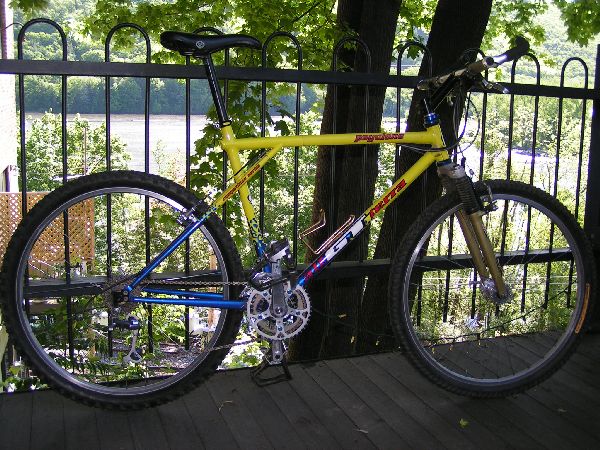
This is my GT Psyclone, which dates from the early 1990s.
The Psyclone was never sold as a bike model, only as a frame
from the "skunk works" Tech Shop in Colorado. There
is a bit of interesting and proud history to recount here.
In the run-up to the Atlanta Olympics, USA Cycling asked GT
to work with them to outfit the US National teams, road and
track, with frames for racing and training. For many years
afterwards, all athletes (not just cyclists) using the Olympic
Training Center facilities in Colorado Springs could check
out a GT-donated bike for cross-training purposes. Forrest
Yelverton was hired to oversee production of road, track,
and mtb frames in steel and aluminum, while the celebrated
Titanium Xizang frames were built for GT by Sandvik. I had
a chance to see the National Team track racers use some of
these steel track bikes at the portable Vandedrome track when
in San Diego, and some friends of ours saw road versions at
the Killington Stage Race at around the same time. Jimi Killen
rode a Psyclone frame just like this one to a gold medal win
at the Mountain Bike Junior World Championships in 1990. We
ran a booth at the Mount Snow expo tent for GT in those early
days and spent a few hours sitting with young Jimi. He was
a nice kid.
This color scheme was called GT Team Scream, an effect in
which the blue and yellow do not fade into each other, but
actually break up into each other. This is achieved by the
laborious technique of applying many individual pieces of
masking tape from a die-cut pattern. As far as I know, GT
only ever used this technique on these Psyclones and on the
Stars and Stripes National Team Bikes, where is was particularly
attractive. Later on some $400 Timberline models got the same
look produced with a decal.
When we first got this frame in I made a beam balance out
of a dowel and hung it in the window balanced against a bag
of potato chips and a bottle of Pepsi. I thought it made for
an interesting question: "which side will take you farther?"
For a month people kept stopping in to ask what exotic material
it was made of and many were astonished to find that it was
good, old-fashioned, 4130 aircraft steel -- drawn into some
fancy shapes. Heat-treated chromoly just has an optimum set
of properties for making a hardtail mtb.
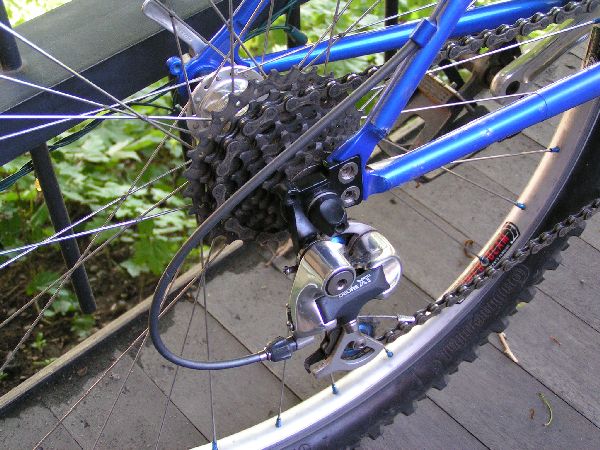
This bike has matching, blue-anodized derailleur pulleys,
spoke nipples, chainring bolts, and headset. Wheels are hand-built
by me (I'm a DT-certified wheelbuilder with 37 years' experience),
using WTB Laser Beam rims and 32 tied-and-soldered Wheelsmith
XL spokes. XT rear hub, Phil Wood front "suspension hub".
XT rear/LX front derailleurs and 8sp XTR brake/shift levers.
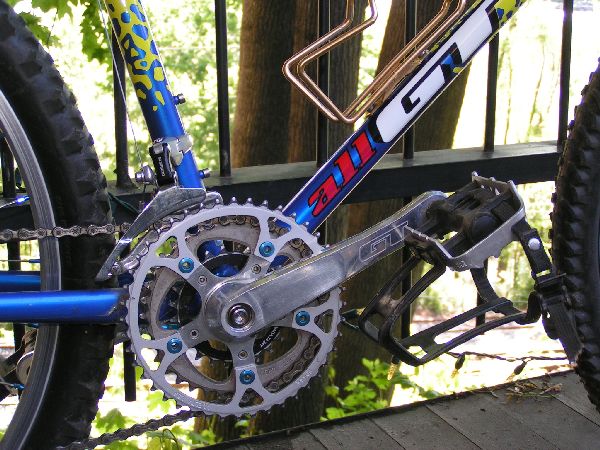
One thing that always bothered me was that GT had a whole
catalog of GT-branded parts for aftermarket sales and none
of it was ever spec'd for any of their bikes. Well, this bike
sports a Profile-made GT CNC crankset spinning on a Titanium,
sealed-bearing GT bottom bracket set. There's also a GT-branded
Easton flat handlebar.
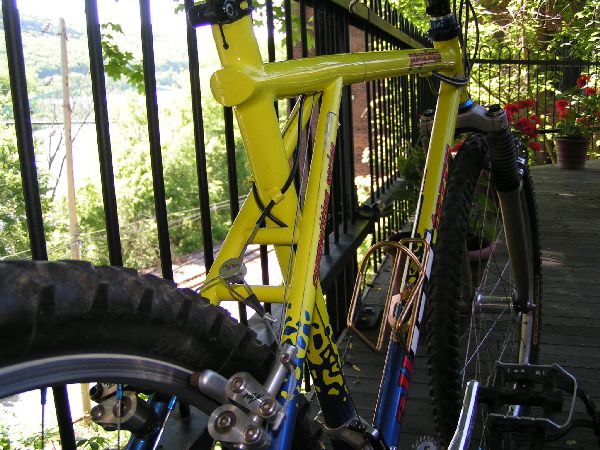
This photo show several things. First, the bike is really
immaculate because it was protected with a urethane tape sold
for the snowboard industry. Not scratch-free, but so close!
Second, you can see how clean the fillet brazing is. Third,
the Onza canti brakes are one of the few designs that permit
independent adjustment of pad angle, toe-in, and rim gap -
as the pads wear down you just loosen the appropriate bolt
and shoot them in without changing any of the other adjustments.
If they had all been made this way we might never have gone
to v-brakes. Finally, the bike still has the Rock Shox Mag21
air-oil fork. This is kind of the crux of the whole bike question:
upgrade to just about any modern fork with more travel and
better performance, or leave it as a period piece because
it still works fine? As Rock Shox founder Paul Turner used
to say, there is more precision machining in this fork than
in the entire rest of the bike put together. There are eight
separate tuning adjustments that can be made, four of them
can be done without dismantling the fork. That's the decision
for whoever ends up with this bike.
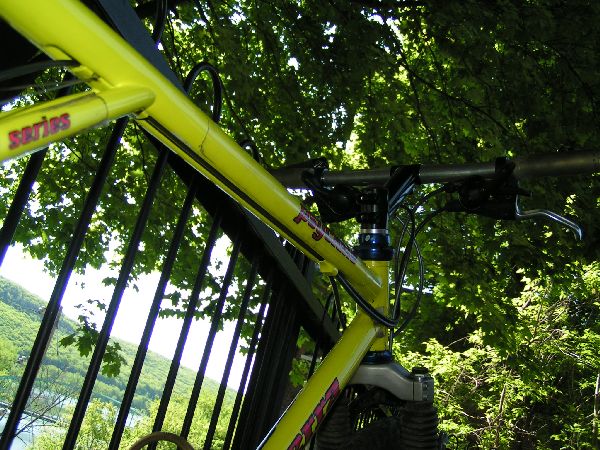
Finally, here you can see the unique GT Groove Tube. This
bike was the first year for this feature and lacks the later
Groove Tube decal. GT challenged True Temper to figure out
a way to make a butted tube with an indented flute that starts
and stops in the middle of the tube. The result was this very
clean cable routing that never snags on anything. This makes
me smile every time I pick up the bike or sit on the top tube.
So, if you want a one-of-a-kind classic, handbuilt, top-of-the-line
piece of cycling history that also happens to be one of the
sweetest-riding mountain bikes you'll ever see, and you happen
to need an 18-inch frame with a 23-inch top tube, you can
have this one for $2000 cash. I began this whole story by
saying it MAY be time to sell it... I'm really still on the
fence, so if there are no takers it will be an excuse to keep
it!
|








